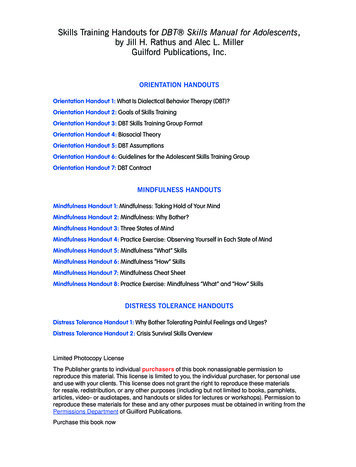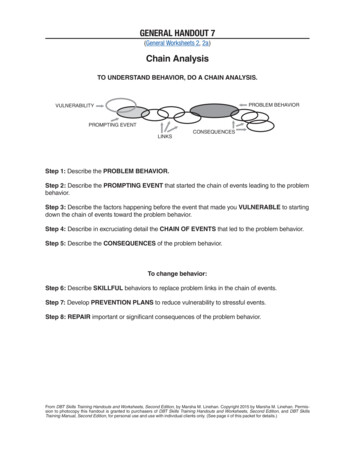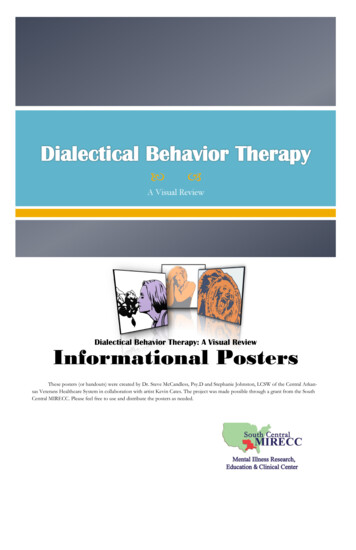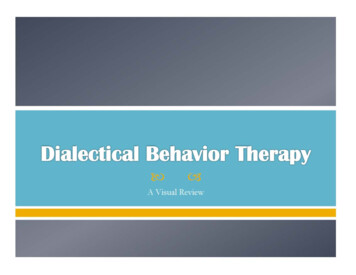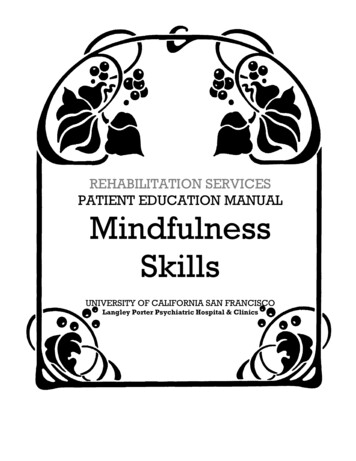
Transcription
Pat Harvey, LCSW-C1USING DBT SKILLS TO REDUCEEMOTION DYSREGULATIONAND REACTIVITY INCHILDREN/ADOLESCENTS ANDPARENTSPat Harvey, LCSW-C, ACSWpath215@comcast.netwww.patharveymsw.comADAA National ConferenceApril,14, 2012
2DisclosureI have a relationship with New Harbinger Publications,the publisher of my book. I have a link on my websitethat results in my receiving a percentage of booksbought through that link. I also receive royaltiesfrom PESI for presentations I have done that theycontinue to market. I have no other relationships toreport.
Pat Harvey, LCSW-C3How DBT began Marsha Linehan found that a purely cognitive behavioralapproach was ineffective in changing the behaviors ofsuicidal individuals; she searched for a more effectivetreatment and added several Zen skills to her treatmentapproach: A focus on the present moment Acceptance of the individual in the moment She learned that acceptance was necessary for change. Mindfulness practice and acceptance became distinguishingcharacteristics of DBT
Pat Harvey, LCSW-C4“The central aim of DBT as a whole is to replace ineffective,maladaptive, or unskilled behavior with skillful responses”(Linehan, 1993) In DBT, problem behaviors are seen as LEARNED RESPONSES tounbearable pain; impulsive behaviors are actually highly effectiveemotion regulation strategies. “A belief in the client’s essential desire to grow and progress , as wellas a belief in her inherent capability to change, underpins thetreatment” (Linehan, 1993) DBT focuses on doing what is “effective” – what helps the person reachhis/her goals. The mental health professional says, “Tell me where you want to go and Iwill tell you how to get there”This framework provides hope for parents and lessens their sense ofhopelessness and helplessness.
Pat Harvey, LCSW-CMINDFULNESS PRACTICEWRITE YOUR NAMES.L.O.W.L.YHow do you hold your pencil?How much pressure do you use?Do your fingers?Does your whole hand move?What is your other hand doing?5
Pat Harvey, LCSW-C6Mindfulness Exercise Follow-upHow did it feel?What did you notice?What did you learn?Did you recognize something you did not expect?Parents who practice this exercise learn to observeinteractions and slow down their responses, giving them timeto find an effective response.
MINDFULNESSMindfulness is paying attention in aparticular way; on purpose, in thepresent moment, and nonjudgmentally.– Jon Kabat-Zinn
www.metroDBT.comStates of MindEmotion MindReasonable MindWISE MIND8
Pat Harvey, LCSW-CMINDFULNESS Reasonable Mind Plans and evaluates logically; Is planful in actions; thinks things through; Is easier to maintain when you are feeling good. Emotion Mind Thinking and behavior are controlled primarily byemotions; Logical thinking is difficult; Facts may be distorted to fit with the affect.9
Pat Harvey, LCSW-C10 Wise Mind Emotions cannot be controlled by intellect or vice versa–they need to be integrated; Intuitive – something that “feels right”, that “feels” likethe truth; Being able to see the whole picture very clearly; When you can feel at peace with a decision – feel“centered”.
Pat Harvey, LCSW-C11 Adolescents Are driven by what they feel they need in Emotion Mind Might “mask” their emotions or otherwise appear competent inreasonable mind Think about the most effective way to handle a situation in WiseMind Parents React in Emotion Mind Lecture or give explanations in Reasonable Mind Respond in Wise Mind We ask clients to ask themselves what Wise Mind would do andwait for the answer.
Pat Harvey, LCSW-C12What Skills Observewords- attend, experience in the moment – without Let thoughts come in and go out, Noticing, sensing, attending. Describe- apply verbal labels – necessary forcommunication and self-control, Use words, label what is observed, but do not judge, Describe a thought – recognize that it is a thought, not afact, Use words to represent what you observe. Participate- without self-consciousness, with attention. Throw oneself totally into something, The ultimate goal: entering wholly into an experience.
Pat Harvey, LCSW-C13How Skills Nonjudgmentally – do not evaluate, Can look at consequences vs. being evaluative about the behavior,o Your behavior is awful vs. your behavior is hurting me. One mindfully - focus on one activity at a time withawareness, Focus attention on only one thing in the moment – washing dishes,talking on the phone, listening to music Effectively - doing what works – what helps reach goals, Do not focus on what might be “right” vs. “wrong”, “fair” vs.“unfair”, Reacting to the reality of the situation, not what we wish thesituation was. Enables parents and their “children” to assess and not judge theirown and each other’s behaviors based on whether or the behaviorshelp them reach their goals
Pat Harvey, LCSW-C14NON-JUDGMENTAL LANGUAGE: NON BLAMINGATTITUDE The language we use is important in determining howwe perceive people and their behaviors and how wefeel about them. The words we use impact: The tone of our work; Our feelings about and responses to clients; Parents feelings about and responses to his/her child. Changing language helps to change attitudes andfeelings. Judgmental language makes us angry, frustrated disappointed When you are less judgmental, you will feel calmer and more accepting
Pat Harvey, LCSW-C15Non-judgmental language: Is non evaluative - does not carry positive or negativeconnotations. Describes in detail – does not label. Describes the behavior or situation in front of you so that someoneelse can see it the same way you do You can only describe what you can observe.o No one has ever observed: Other’s intentions Other’s thoughts Other’s feelings Causes Reasons Meanings
Pat Harvey, LCSW-C16 Judgments are often short-hand for statingconsequences: giving up judgments does not meandenying consequences Non-judgmental language does: Look at the consequence of the behavior. For example:o “When you act that way, I feel sad.”o “If you behave that way, you may be suspended.”o “If you do not change your behavior, you may not get what youwant or meet your goals.” Allow for preferences and opinions
Pat Harvey, LCSW-C17Non-judgmental language also: Does not make assumptions about individuals,behaviors or motives; Does not assume the intent of the behavior;o Does not assume that the intent of behavior is to impact someone else ina negative way; Separates the effect of the behavior from its assumed intent;o Regardless of how the observer FEELS because of the behavior,assumptions cannot be made about the INTENTION of the behavior. Is important for clinicians and for parents to learn andpractice; it minimizes feelings of anger, frustration anddisappointment.
Pat Harvey, LCSW-C18DIALECTICS In Dialectical Behavior Therapy an individual: Learns that two things that seem contradictory can both be true Learns to move from thinking in polarities, black and white (either/or) andextreme thinking to finding ways to entertain and integrate contradictorythoughts –-that include:o The need to accept oneself AND the need to change;o Getting what one needs AND not losing what one needs if onebecomes more competent;o Maintaining personal integrity and validating one’s own view of oneselfand one’s suffering AND learning new skills that enable one to movebeyond suffering. Finds ways to accept BOTH sides of a situation and finda synthesisthat does not negate the reality of either.o “The middle path is not halfway between extremes but a completely new path”o The middle path is very important in families – between parents and childrenand between each of the parents.
Pat Harvey, LCSW-C19BALANCING ACCEPTANCE AND CHANGE This is DBT’s Core Dialectic and using it is key toeffectiveness DBT balances Two Truthso You can accept an individual as he/she is in this moment ANDo Expect him/her to change and make his/her life better In DBT, there will be a focus on: Helping clients to increase their ability to accept and tolerate painfulfeelings, their current life situations and themselves AND Helping clients learn new skills and behaviors that will enhance life. Acceptance is necessary for change This is true for the parents as well as for the adolescent
Pat Harvey, LCSW-C20Balanced Thinking – Avoids all or none,accepts “both” Acceptance and hope (Parents often feel that if they accept they give up hope; thisdialectic needs to be re-enforced so they do not become hopeless) Independence and assistance Choices and limits Giving in and choosing priorities Firmness and gentleness
Pat Harvey, LCSW-C21Balanced language – avoids extremewords Avoid extreme words Minimize use of always, never, everyone, nobody Use sometimes, occasionally Help clients to use less extreme or absolute words When you change language and minimize absolutelanguage, parents and kids are less angry, disappointedand frustrated. There is more possibility of hope
Pat Harvey, LCSW-C22DBT Balance and Clients As a professional you balance understanding your clients’behavior in the context of their life AND helping them tolearn skills to manage their behaviors better. An emphasis either on acceptance or on change is usually ineffective In DBT, clients are told: “I see how you feel that way. Nowwhat can we do to make things different or to help you feelbetter?” It is important to remember, and to remind your clients, thatbehaviors have been learned; they can be unlearned and newbehaviors can be learned to replace them.The acceptance that someone is doing the best he/she can in thecontext of his/her life is as true for parents as for the adolescent .
Pat Harvey, LCSW-C23VALIDATION“To Move to Change, You Have to First Accept” Validation means letting someone know you:Are listening;Understand how he/she feels;Are taking him/her seriously;Are understanding his/her behavior within the context of his/her lifecircumstances; Accept him/her. That you have found what genuine and valid (the “kernel of truth) inhis/her communication Validation does NOT mean that you agree or that you like what theperson is doing, feeling or saying. Validation is a communication of empathy and acceptance.
Pat Harvey, LCSW-C24 Fruzetti Research (presented in 2005) Validation is highly associated with healthier family and individualfunctioning. Validating and invalidating parent behaviors predict theadolescent’s self-esteem, awareness of emotion, familysatisfaction, level of depression etc. Mothers in the study had reduced depression and increasedrelationship satisfaction. Validating responses are soothing. Invalidating responses are aggravating. Reducing invalidating behavior in one family member:o Increases positive affect in the other;o Decreases negative affect in the other;o Increases self-disclosure (emotional expression). A person’s emotional arousal can get in the way of validating responses.Validation serves to de-escalate emotional situations
Pat Harvey, LCSW-CValidate a child/adolescent’sexperiences by:25 Communicating that you are listening and not judging or blaming; Acknowledging how hard it is when his/her emotions seem to spin out of control he/she feels powerless to control them.How painful it must feel to behave in ways that he/she may regret later or thatupset others.Acknowledging how difficult and even embarrassing it is o be “different” whenhe/she wants to be like everyone else.Recognizing and acknowledging that each member of the family is effected byevery other member of the family in a transactional wayAcknowledging the difficulty in his/her lives and letting him/her know you accepthim/her in this moment even while you are helping him/her to change his/herbehaviors.Accepting that the child/adolescent is doing the best he/she can with thecircumstances and difficulties in his/her life and the ways he/she have learned tomanage their difficulties.If kids feel validated, they will be better able to receive feedback and changetheir own behaviors.
Pat Harvey, LCSW-C26Validate a parent’s experiences by Being accepting and non-judgmental Recognizing and acknowledging that each member of the family is effected by every other member of the family in atransactional wayAcknowledging that they have faced difficulties in their homedue to the behaviors of a child with intense emotionality thatthey care for 24/7.Recognizing that their fears for the child might make it hard tomake changes in how they parentRecognize that they may have been given contradictory anddifferent opinions about what to do.Acknowledge that others blame them for the behaviors of theirchild.Acknowledge that they are doing the best they can even whilethey are learning to parent more effectively.
Pat Harvey, LCSW-C27Validating and Invalidating behaviors infamilies:adapted from Dimefff and Koerner (2007)Validating Behaviors Paying attention Helping the other person to clarifywhat he/she is thinking, articulatingwhat the other person MIGHT feel Normalizing the other person’sfeelings or behaviors Empathy, acceptance of the otherperson, treating the other person asyou would anyone else Offering self-disclosure/vulnerabilityin the context of the other person’svulnerabilityInvalidating Behaviors Not paying attention, being distracted, being anxious to endthe conversationTelling the other person whathe/she DOES feel or SHOULD feelPathologizing or criticizing whatthe other person thinks or feelsPatronizing, condescending ortreating the other person as fragileor incompetentNot responding to or validiatingthe other’s self-disclsosure
Pat Harvey, LCSW-C28PROS AND CONS OF BEHAVIORS A way to evaluate choices between behaviors, to assess whatbehavior will be the most effective in the long run Look at Prosand Cons of each possible choice. For the adolescent - to use safe or unsafe behaviorso Evaluate the pros of using familiar behaviors which may be unsafe ordangerouso Evaluate the cons of using the familiar behaviors – what is the long-ermconsequence of this behavior?o Look at the pros of a more skillful behavior – will they be safer Is it more effective in reaching goals even if it less effective in managing painin the moment?o What are the cons of the safer behavior – why is it difficult to use it? Does it work in the short-term to alleviate stress?
Pat Harvey, LCSW-C29 For the Parent – to use the same or different behaviors, to say yes towhat the adolescent wants or set a limit or expectation Pros of continuing to respond to their child in the same/familiar/automaticwayo Does it feel less stressful?o Does it create less emotionality in their child? Cons of responding to their child in the same wayo Is it effective in the long-term – does it lead to the changes the parent wants? Pros of changing behaviors and attempting to respond differentlyo Will a different response or different choice lead to a different behavior in theirchild?o Will a different response be more effective in the long term? Cons of trying new behavioral responseso How will the adolescent respond in the short term to the changes in the parents?o What are all the possible outcomes of a change in the parents’ behaviors? This process can also be used in making decisions and choices that aredifficult.
Pat Harvey, LCSW-C30For adolescents: Evaluating how to manage distressFamiliar, Possible Unsafe BehaviorsProsConsImmediate reliefLoss of trustSafe, Adaptive ChoicesProsSelf-esteemConsFeel the pain
Pat Harvey, LCSW-C31For Parents: Evaluating how to respond to the adolescentFamiliar – responding in the way the adolescent wantsProsLess emotions from childFeel more comfortable in roleConsNO change in patterns, or in adolescentResponding Differently, Setting Different Limits or ExpectationsProsPossible change in adolescent’s behaviorsFeel more effectiveConsIncrease anxietyPossible dangerous behavior in adolescent
Pat Harvey, LCSW-C32The lessons of Pros and Cons: “Ineffective” behaviors have a purpose – They provideimmediate relief from pain. “Effective” choices have drawbacks – The student hasto sit with the discomfort of the distress. The desire for immediate relief of anxiety and pain ispresent for parents and children and is hard to let goof. Individuals need to accept some pain and discomfortin order for change to occur. Mental health providers need to understand andvalidate the pain and support the individuals throughit. DBT is about long term change, not short-term relief.
Pat Harvey, LCSW-C33Adolescents and Emotion Dysregulation Mood dependent behaviors (driven by a desire to escapeor avoid painful emotions) that might include: Self- harm and suicidality Aggression, threatening Eating disorders Substance abuse Risk taking behaviorso Including risky sexual behaviors Delinquent behaviorso Including stealing from parents, shopliftingo Running away School refusal or failure Unrelenting crises Anxiety
Pat Harvey, LCSW-C34Impact on Family On Parents Constant fears and anxiety about safetyo The Dialectic of trying to keep their child safe while knowing that theycannot control their behaviors or stop someone who has a strong intentto die Dialectically trying to decide what is “normative” and what is“pathological”o Trying to keep their child safe and monitor their behaviors while alsotrying to avoid ongoing power struggles and aggressive reactionso Trying to figure out where and how to set limits and have expectationswhen a child may be unsafe, engaging in risky behaviors, and/ordemanding increasing privileges Trying to get their kid to partake in treatment and takerecommended medicationso Searching for services that are effective Feeling blamed, feeling responsible, feeling guilty
Pat Harvey, LCSW-C35 On Siblings Sense of loss that their family is not like other families, their siblingis not like other siblings Fears, Anxiety about the aggression in the houseo Concerns and fears about what is happening to their parents Feelings about “unfairness” when they have to do chores theirsibling does not have to do Not getting attention when it is needed or feeling guilty when theyneed or want attentiono Wondering if they have to be “sick” to get their needs met – recognizingthat meeting expectations means not getting as much attention Guilt over having success that their siblings may not have Parents have to find a way to balance the needs of alltheir children while maintaining the safety of everyone.
Pat Harvey, LCSW-C36DISTRESS TOLERANCE SKILLS Crisis Survival Skills Help someone get through the moment of pain/distress withoutmaking the situation worseo Distracto Self-sootheo IMPROVEo Pros and Cons Treatment providers should know which skills help their clients Accepting Life in the Moment Skills Help someone to accept “what is”. Accepting life as it is, rather than resisting or trying to changereality, helps individuals to suffer less.o Radical Acceptanceo Turning the Mindo Willingness and Willfulness
Pat Harvey, LCSW-C37 Distress Tolerance Skills are: “ ways of surviving and doing well in even terrible situationswithout resorting to behaviors that will make the situationworse.” Skills for accepting life as it is in the moment.o This reduces suffering which occurs when fighting reality andrefusing to “accept” Ways to bear pain skillfully. Necessary to manage the stress of change so that the clientdoes not resort to impulsive actions that will interfere withmovement toward change Ways to get through the situation even while continuing towork on changing the situation
Pat Harvey, LCSW-C38Crisis Survival Skills Each crisis survival skill is a method for coping withoverwhelming emotions and tolerating situations. These are strategies for getting through asituation; they are not cures. Crisis survival skills will provide the client only ashort term benefit Those short term benefits are a major feat and can lead totremendous life changes. Short-term benefits will allow the client to continue to find long-termsolutions
Pat Harvey, LCSW-C39Distracting – reducing contact with emotional stimuli Wise Mind ACCEPTS: Activities – keeping attention on other things Contributing – taking care of others Comparisons – to worse situations Emotions – opposite to what one is feeling Pushing Away – decrease contact with painful cues Thoughts – thinking of other things Sensations – intense other sensations interfere with thephysiological component of current negative emotions
Pat Harvey, LCSW-CDistract Do something else Imagine something else Sense – generate sensations to interruptyour focus on pain Think about something else Remember times when things were better Accept that pain is part of life Create meanings Take opposite action. Do the reverse ofwhat you feel.40
Pat Harvey, LCSW-C41Self-Soothing -comforting, being kind and gentle to one self,doing things that feel good, Find ways to relax and calm using the 5 senses - Vision,Hearing, Smell, Taste, Touch May include taking a warm bath, using lotions or incense, listeningto music, drinking warm tea; This is individualistic – what soothes one person may not sootheanother; It is helpful to have a list of soothing activities;o It may be hard to remember what to do when emotionally dysregulated– looking at the list helps someone to remember.o Sharing the list with others allows them to coach and remind someonewhat is helpful.o Clinicians should know this list as well so they can coach in a crisis
Pat Harvey, LCSW-C42 Nurturing, comforting and being gentle withyourself. Sometimes, when people go through a crisis, theybeat themselves up with self criticism. The skillful approach to getting through a crisis isto be gentle with yourself so that when the crisis isover you are not in worse shape than when itbegan.
Pat Harvey, LCSW-C43Issues in Teaching Self-Soothing Self thoughts such as “I don’t deserve it.” Teach clients to self soothe as a way to lower theiremotional baseline and to decrease emotional vulnerability.Don’t wait until you are in crisis to use these skills. Some people self soothe frequently as a way of avoidingdealing with problems. Encourage clients to practice using various senses ratherthan limiting themselves to one sense that might be morenatural to them. For people who binge eat, it is best not to use triggeringfoods for self soothing since the effects often back fire.
Pat Harvey, LCSW-C44Improve the Moment - replacing immediatenegative events, thoughts, responses with more positiveones IMPROVE – find the skill that works: Imagery – take oneself to a different, and safe, place Meaning – create or find meaning in one’s life Prayer – opening of oneself to the moment (not begging or “why me?”)Relaxing – changing how the body responds to stress, acceptingwith one’s body can aid accepting with one’s mindOne Thing in the Moment – focusing can provide time to settledown –– stay focused on the present, not on all of the pain of thepast or futureVacation – retreat into oneself for a brief time or have someoneelse take care of oneEncouragement – cheerlead oneself through the crisis as if one ishelping someone else
Pat Harvey, LCSW-C45Accepting life in the Moment Skills“The skills to build a life when the life you have is not the life you want” (Linehan) Acceptance of “what is” will Bring a sense of calm Allow for more effective problem solving, Allow you to see opportunities in the situation that youwere not able to see when you were “fighting reality”. Enable you to see more opportunities for change andhope.
46Pat Harvey, LCSW-C“The curious paradox is that when Iaccept myself just as I am, then I canchange”-Carl Rogers
Pat Harvey, LCSW-C47Guidelines for Accepting Reality: Ways to getone’s body ready so that one’s mind can begin to accept what “is”. Breathing/Observing one’s breath exercises : Focus on breathing, helps to relax; Helps individuals to accept and tolerate themselves, the world andreality as it is. Half-smiling exercises: Relax face, neck and shoulder muscles and half-smile; Accepting and tolerating with one’s whole body. Awareness exercises: Helps with acceptance; Become aware of simple things.
Pat Harvey, LCSW-C48Accepting life in the Moment Skills“ Turning the Mind – An active process to accept what is, choosing to accept Willingness vs Willfulness: WILLINGNESS (doing what works in the situation, responding towhat “is”) VS. WILLFULNESS (imposing one’s will on reality, refusingto do what is needed in the moment). Radical Acceptance: Letting go of fighting reality; Acceptance turns suffering that cannot be tolerated into pain thatcan be tolerated; Acceptance does not mean approval.
Pat Harvey, LCSW-C49Radical Acceptance Willingness You allow the world to be what it is You agree to participate with the world You play the hand you’re dealt
Pat Harvey, LCSW-CRadical Acceptance Willfulness When willfulness shows up:o Notice ito Radically accept ito Turn your mind towards acceptance and willingnesso Try a willing postureo Ask yourself, “What’s the threat?” We may feel threatened WILLINGNESS is what you will need to overcome it!!50
Pat Harvey, LCSW-C51Radical Acceptance Radical Complete and total Acceptance Acknowledgement of what is Accept with your mind, your heart, and your bodyA feeling that a burden has liftedA feeling of freedomA feeling you are ready to move onRadical acceptance transforms suffering into ordinary pain.Suffering is the nonacceptance of pain.
Pat Harvey, LCSW-CRadical Acceptance Options for painful problems Solve the problem Change how you feel about it Accept it Stay miserable52
Pat Harvey, LCSW-C53DISTRESS TOLERANCE SKILLS Help Clients to learn: How to take care of themselves when they want orneed to; The importance of using skills to get through crises; oflearning how to calm themselves To radically accept their life as it is;o Helps them to “suffer less”;o Helps them to be more effective in their responses. That acceptance leads to seeing more opportunities forchange and hope.
Pat Harvey, LCSW-C54EMOTION REGULATION SKILLS In DBT, difficulties in regulating painful emotions arecentral to the behavioral difficulties; From this perspective, painful feelings are “the problem to besolved”; Dysfunctional and destructive behaviors are often behavioralsolutions to intolerable pain;o They do, in fact, regulate emotions. The goal of Emotion Regulation is to reduce suffering, notget rid of emotions. In order to manage emotions more effectively, one needsto be able to observe, understand, and express emotions.
Pat Harvey, LCSW-C55The Story of Emotion Feelings do not come out of nowhere. They do not directly follow anevent. They are not caused by something that happened, or bysomeone else. FEELINGS ARE CAUSED BY A PERSON’S BELIEF SYSTEM/BY APERSON’S INTERPRETATION ABOUT SOMETHING THAT HAPPENED.Prompting event Belief or Interpretation of the Event Emotion/FeelingThoughts Feelings Behaviors
Pat Harvey, LCSW-CVulnerability/Contributing Factors Recent history that causes one to focus on the negativeor that depletes the energy necessary to stay out ofEmotion Mind. How were you feeling before the event happened? Did you get enough sleep? Did you already have emotions from something elsegoing on?56
Pat Harvey, LCSW-CPrompting Event The event that triggered the response –may come from inside the individual or may besomething in the environment. What happened? What happened to cause you to feel something?57
Pat Harvey, LCSW-CInterpretation/Beliefs about the Event Thoughts, feelings, or beliefs ABOUT the event. What did you THINK about what happened? Did the event trigger memories, thoughtsabout similar situations? How did your past effect how you viewedthis situation?58
Pat Harvey, LCSW-C59Biological Changes/Body Sensations Facial muscles; body changes (heart rate etc.);Brain changes; “sensing”; action urges; One has to “sense” his/her body in order to regulateemotions; One cannot “quit feeling”; The urge – but not the behavior – is part of the emotion. How did your body begin to feel? Do you find yourself clenching your fists? Tensingyour shoulders? “Butterflies” in your stomach?
Pat Harvey, LCSW-C60Communication/Expression and Action Find a way to express or NAME what one is feeling? May be verbal or non-verbal; May include body language, words, action, facialexpression. How do you or can you express what you are feeling? Is there an action that can represent your feelings? Is there a word that describes what you are feeling? Will you follow the action urge or inhibit it and behavedifferently?
Pat Harvey, LCSW-CAftereffects/Secondary Emotions The effects that intense emotions have onmemories, thoughts, thinking, physical functioningand behavior. What did you think or do after the emotion? What didyou feel about the emotion you have or had? Did your emotion prompt another emotion oranother event?61
Pat Harvey, LCSW-C62 The Story of Emotion for Parents and Adolescents oftenoverlap The aftereffect of the behavior of the parent may be a trigger foran adolescent The behavior of an adolescent may be a trigger for a parent Parents’ effectiveness depends on being mindful of When they are vulnerable and when their “child” is vulnerableo To avoid difficult situations at those times, if possible What triggers them and what triggers their childo To avoid the triggers or prepare when they are inevitable How they and their child interpret eventso To be aware of how their child may be perceiving a situation
Pat Harvey, LCSW-C63 Parents’ effectiveness depends on being mindful of When they are vulnerable and when their “child” is vulnerableo To avoid difficult situations at those times, if possible What
12 What Skills Observe - attend, experience in the moment – without words Let thoughts come in and go out, Noticing, sensing, attending. Describe - apply verbal labels – necessary for communication and self-control, Use words, label what is observed, but do not judge, D
